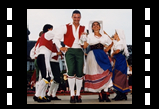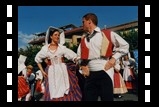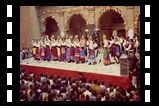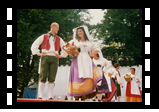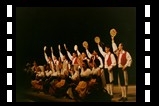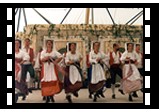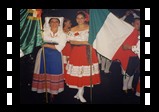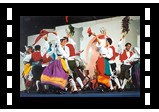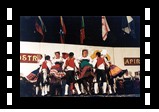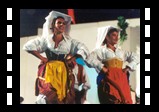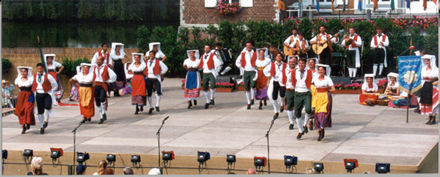
The
folklore presented by "URBANITAS" reflects the characteristics
ot the region from which it derives, ínasmuch as the dances
are spritghtly and vivacious, expressing as they do the
joy of living and of having fun. The selections of the
repertoire are founded on original musical and choreographic
executions, reconstructed thanks to painstaking and scrupulous
research.
In former times our area was predominately rustic, on
which account all the dances relate to culminating seasonal
events of agriculture such as threshing and the grape
harvest, the undertaking of which tasks invariably offered
a most propitious occasion for a festival.
Among
the more engaging of our performances stand out "La
Piazza di Montegallo", a very vivacious dance that
derives its nane from the square of a stereotypes town,
constituting a symbol to indicate that each and every
important festival was concluded with a dance in the town's
main square, and "U Vallu Che Non Va Vé" (the
Ill-Suited Dance), a dance aimed at inducing all the girls
present to take part, both pretty and ugly, both capable
and incapable of dancing, whose rhythm is consequently
slow, with simple movements, and with an ongoing exchange
of partners.
Although
some of the dances included in our repertoire originated
in faraway countries, they have long since become, nevertheless,
deep-rooted in our local tradition. The "Mazurka",
having its origin in Mazowia, that is, in east central
Poland, was introduced into Italy during the Napoleonic
occupation by bohemian, croatian and austrian soldiers,
who at that time waged war against the armies of Murat.
Popular, especially in central and northern Italy, the
Mazurka was transformed by the inhabitants of the Marches,
both in regard to the music and to the original movements,
thus adopting itself to local tastes and culture.
The
"Manfrina", a dance quite obviously of courtly
ancestry originating in Piedmont, was already popular
in the French court by the year 1700.
Introduced into our region at the end of that century,
it slowly became an integral part of our popular patrimony,
thanks to the servants of our local nobility. Executed
to the accompaniment of stringed instruments, it is still
danced today under the direction of a caller, who calle
out the successive dance steps while the music continues
to play.
With
the passage of time and by virtue of meticulous and unrelenting
research, it has been possible both to rediscover and
to recover movements and musical styles which otherwise
would have been irretrievably lost.
Thanks to such tireless efforts dances such as "Lo
Sterpe" can be faithfully performed today, a dance
characterized by an unusually sprightly rhythm and a rapid
succession of dance patterns, and "Tre zumpi Sull'Ara",
reconstructed on the basis of an old waltz.
Since
in former times, opportunities for paying court to a woman
were quite rare, dancing was an all-important occasion
for getting together and socializing. This aspect, characteristic
of all our folklore dances, is particularly evident in
the "Montagnola", in which a sailor is portrayed
in wooing one of our local girls as she goes to the fountain
with her pitcher to draw water, and in "Vallate Vallerì",
a dance with which holidays were ushered in at the home
of the estate owner or of hie steward, in which all of
those share-croppers attended who formed part of the métayage.
On such occasione only the most proficient dancers intervened
directly, who, whether out of genuine fondness or out
of a sense of duty, wooed either the wife of the estate
owner, or her daughter.
Of
all the dances included in our repertoire the most typical
and characteristic is without doubt the "Saltarello",
noticeably different in its music and beat as executed
in the various towns of our region, whereas in Apiro it
assumes an exceptional liveliness, so much so that it
has been defined the Earthquake Saltarello. It is executed
by "URBANITAS" with the utmost attention being paid to
detail, inasmuch as on the stage an authentic threshing-floor
is constructed together with accompaning scenery, such
being the setting in which the dance was performed to
celebrate the end of the laborious seasonal harvest. The
Saltarello is the courting dance par excellence: the couple
invariably gaze at each other smiling, as they wink at
each other and incite one another intermittently. Whereas
the man attempts continually to get ever closer to his
partner, she, on the other hand, though initially avoiding
him in order to whet his desire even more, fínally, however,
draws closer to him thus indicating that she welcomes
the gallantry of her suitor.
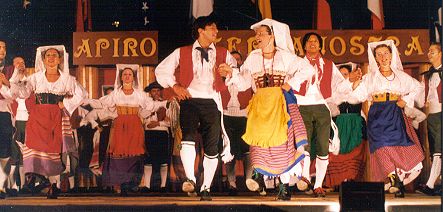
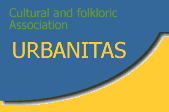
![]()
